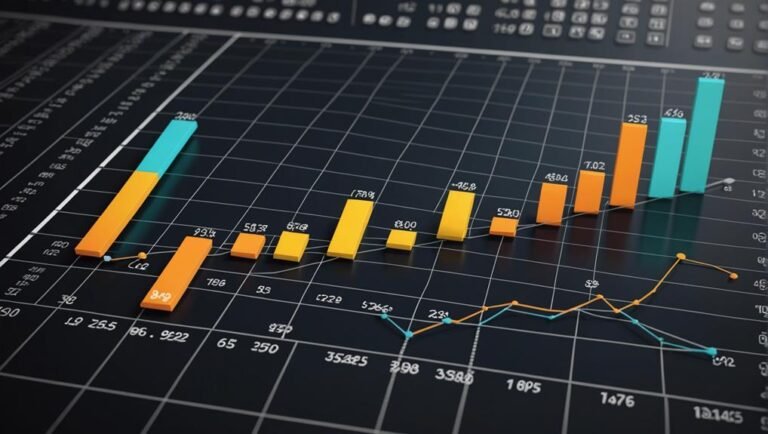Decoding Forex Trading: Unveiling Global Currency Markets
The forex market showcases a dynamic mix of institutional investors and individual traders impacting currency valuations. Understanding their motivations is key. Currency pair trading relies on correlation analysis and economic indicators like GDP. Market sentiment and global events also play vital roles. Daily operations involve trend analysis and monitoring economic indicators to forecast movements. Liquidity factors, such as volume and efficiency, enable easy trade maneuvering. Managing risks with effective strategies safeguards against market volatility. Intrigued by the complexity of global currency markets?
Key Takeaways
- Institutional investors and individual traders shape currency valuations and market dynamics.
- Currency correlation, economic indicators, and market sentiment influence trading opportunities.
- Market trends, economic indicators, and global events impact daily forex operations.
- High liquidity facilitates easy trade entry/exit, reducing risks like slippage.
- Effective risk management and trading strategies aim for consistent profitability in forex trading.
Understanding Forex Market Participants
In the dynamic world of forex trading, market participants encompass a diverse array of entities ranging from major financial institutions to individual traders, each playing a pivotal role in shaping the landscape of this vast and liquid market.
Institutional investors, such as central banks, commercial banks, and hedge funds, wield significant influence due to the large volumes they trade, impacting currency valuations. On the other hand, individual traders, including retail traders and small-scale investors, contribute to market liquidity and play a role in price discovery.
Understanding the motivations and strategies of both institutional investors and individual traders is essential in deciphering the complexities of the forex market and anticipating market movements. The interaction between these two participant groups forms the foundation of market dynamics in forex trading.
Exploring Currency Pair Trading Dynamics
Delving into the intricacies of currency pair trading dynamics reveals the interplay of various economic factors shaping the forex market landscape. Analyzing currency correlation and the impact of economic indicators are important in understanding how currency pairs move in the forex market. Here are key points to keep in mind:
- Currency Correlation Analysis: Examining how different currency pairs move in relation to each other can help traders diversify risk and spot potential trading opportunities.
- Impact of Economic Indicators: Economic data releases such as GDP, employment figures, and interest rate decisions can greatly influence currency pair movements.
- Market Sentiment: Investor sentiment towards a particular currency can drive its value relative to other currencies.
- Global Events: Geopolitical events and news can trigger volatility in currency pairs, requiring traders to stay informed and agile in their strategies.
Unveiling Daily Forex Market Operations
Currency pair trading dynamics in the forex market are intricately connected to the daily operations that drive market movements and participant interactions. Analyzing market trends is vital for traders to make informed decisions. Interpretation of economic indicators such as GDP growth, employment rates, and inflation helps forecast currency movements.
Daily forex market operations involve a continuous flow of buy and sell orders from various participants worldwide, influencing exchange rates. Traders monitor geopolitical events, central bank announcements, and economic data releases to anticipate market shifts. Understanding these factors is essential for maneuvering the fast-paced environment of the forex market.
Analyzing Forex Market Liquidity Factors
Examining the depth of liquidity in the forex market provides critical insights into trading dynamics and market efficiency.
- Market Liquidity Importance:
- High liquidity allows for easy entry and exit of trades.
- It reduces the risk of slippage and price manipulation.
- Enhances market efficiency and price discovery mechanisms.
- Provides a better trading experience for participants.
Understanding the trading volume and liquidity factors in the forex market is essential for traders to navigate the market effectively. Market liquidity guarantees that transactions can be executed swiftly and at stable prices, contributing to a more efficient and transparent trading environment.
Managing Risks and Trading Strategies
An integral aspect of successful forex trading lies in the adept management of risks and the strategic implementation of trading methodologies. Risk management in forex trading is essential to safeguard against market volatility and unforeseen events.
Traders must assess and mitigate market, interest rate, credit, leverage, and operational risks to protect their investments. Understanding trading psychology is also vital for making informed decisions and controlling emotions during trading activities.
Implementing effective risk management strategies can help traders navigate the complexities of the forex market and enhance their overall trading performance. By combining sound risk management practices with well-thought-out trading strategies, traders can aim for consistent profitability and long-term success in the dynamic world of forex trading.
Conclusion
To sum up, the Forex market plays a vital role as a central hub for global currency exchange, with trillions of dollars traded daily by a diverse range of participants.
One fascinating statistic is that the average daily trading volume in the Forex market exceeds $6.6 trillion, highlighting the immense liquidity and opportunities present in this dynamic marketplace.
Understanding the complexities, risks, and strategies of Forex trading is essential for maneuvering through the intricacies of the global currency markets.







